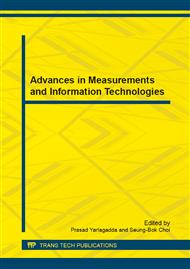p.530
p.534
p.540
p.544
p.550
p.554
p.561
p.567
p.573
Research of Time Delay Estimation Based on Higher Order Statistics
Abstract:
The time delay estimation (TDE) is one of the most important techniques of characterization signal parameter. Delay parameter estimation is active in the field of signal processing. In this paper, On the basis of the basic theory method of time delay, the correlated time delay estimation, mutual-cumulants estimation and bispectrum estimation are analysed and discussed. Theoretical analysis and experimental results show that three methods is effectively used in time delay test, but higher order statistics (HOS) method can achieve the best effect. The HOS estimation method has many advantages, such as time delay estimation accuracy, high relative error small for Gaussian noise elimination ability.
Info:
Periodical:
Pages:
550-553
Citation:
Online since:
February 2014
Authors:
Price:
Сopyright:
© 2014 Trans Tech Publications Ltd. All Rights Reserved
Share:
Citation:


